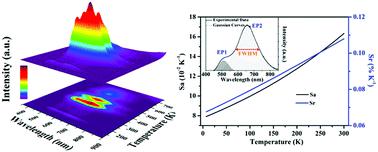当前位置:
X-MOL 学术
›
J. Mater. Chem. C
›
论文详情
Our official English website, www.x-mol.net, welcomes your feedback! (Note: you will need to create a separate account there.)
Investigation on the photoluminescence and thermoluminescence of BaGa2O4:Bi3+ at extremely low temperatures
Journal of Materials Chemistry C ( IF 6.4 ) Pub Date : 2020-12-23 , DOI: 10.1039/d0tc05122e Huimin Li 1, 2, 3 , Haiyan Wu 1, 2, 3, 4, 5 , Ran Pang 1, 2, 3 , Guanyu Liu 1, 2, 3 , Su Zhang 1, 2, 3 , Lihong Jiang 1, 2, 3 , Da Li 1, 2, 3 , Chengyu Li 1, 2, 3, 4, 5 , Jing Feng 1, 2, 3 , Hongjie Zhang 1, 2, 3
Journal of Materials Chemistry C ( IF 6.4 ) Pub Date : 2020-12-23 , DOI: 10.1039/d0tc05122e Huimin Li 1, 2, 3 , Haiyan Wu 1, 2, 3, 4, 5 , Ran Pang 1, 2, 3 , Guanyu Liu 1, 2, 3 , Su Zhang 1, 2, 3 , Lihong Jiang 1, 2, 3 , Da Li 1, 2, 3 , Chengyu Li 1, 2, 3, 4, 5 , Jing Feng 1, 2, 3 , Hongjie Zhang 1, 2, 3
Affiliation

|
Most of the long persistent luminescence (LPL) materials are investigated at room temperature or higher temperatures. However, LPL materials have promising applications in extremely low-temperature conditions. Here, we report a phosphor, namely BaGa2O4:Bi3+, with LPL that can act as a biological-temperature indicator and thermometer at extremely low temperatures. The traps were investigated in detail with the lowest and highest trap densities of 2.39 × 106 and 7.23 × 107, respectively. The trap distribution ranges from 150 to 750 K in the thermoluminescence (TL) spectrum with corresponding trap depths ranging from 0.310 to 0.716 eV. The TL spectra show that the distribution of the carriers stored in the traps to two emission centers changes with the temperature rising. The low-temperature steady-state photoluminescence (PL) was also investigated. Since the CIE colour coordinates are almost unchanged and the integrated emission intensity at 300 K was still maintained at 88.2% of 7 K, the phosphor presents a stable colour and intensity output. By decomposing the PL spectra at different temperatures, we noticed that one of the deconvoluted full width at half-maximum (FWHM) bands is temperature-sensitive; the thermometer-related parameters were calculated with the maximum values of Sa and Sr to be 0.163 and 0.108%, respectively. Our concept of investigation may promote the follow-up exploration of LPL phosphors under extreme conditions.
中文翻译:

BaGa2O4:Bi3 +在极低温度下的光致发光和热致发光研究
大多数长时间持续发光(LPL)材料在室温或更高温度下进行了研究。但是,LPL材料在极低温条件下具有广阔的应用前景。在这里,我们报告了一种磷光体,即具有LPL的BaGa 2 O 4:Bi 3+,它可以在极低的温度下充当生物温度指示器和温度计。详细研究了陷阱的最低和最高陷阱密度分别为2.39×10 6和7.23×10 7, 分别。在热发光(TL)光谱中,陷阱分布范围为150至750 K,相应的陷阱深度范围为0.310至0.716 eV。TL光谱表明,陷阱中存储的载流子分布到两个发射中心随温度升高而变化。还研究了低温稳态光致发光(PL)。由于CIE颜色坐标几乎不变,并且300 K时的积分发射强度仍保持在7 K的88.2%,因此磷光体呈现出稳定的颜色和强度输出。通过分解不同温度下的PL光谱,我们注意到在半最大(FWHM)波段解卷积的全宽度之一是温度敏感的。用S的最大值计算与温度计有关的参数a和S r分别为0.163和0.108%。我们的研究理念可能会促进在极端条件下对LPL磷光体的后续探索。
更新日期:2021-01-13
中文翻译:

BaGa2O4:Bi3 +在极低温度下的光致发光和热致发光研究
大多数长时间持续发光(LPL)材料在室温或更高温度下进行了研究。但是,LPL材料在极低温条件下具有广阔的应用前景。在这里,我们报告了一种磷光体,即具有LPL的BaGa 2 O 4:Bi 3+,它可以在极低的温度下充当生物温度指示器和温度计。详细研究了陷阱的最低和最高陷阱密度分别为2.39×10 6和7.23×10 7, 分别。在热发光(TL)光谱中,陷阱分布范围为150至750 K,相应的陷阱深度范围为0.310至0.716 eV。TL光谱表明,陷阱中存储的载流子分布到两个发射中心随温度升高而变化。还研究了低温稳态光致发光(PL)。由于CIE颜色坐标几乎不变,并且300 K时的积分发射强度仍保持在7 K的88.2%,因此磷光体呈现出稳定的颜色和强度输出。通过分解不同温度下的PL光谱,我们注意到在半最大(FWHM)波段解卷积的全宽度之一是温度敏感的。用S的最大值计算与温度计有关的参数a和S r分别为0.163和0.108%。我们的研究理念可能会促进在极端条件下对LPL磷光体的后续探索。


























 京公网安备 11010802027423号
京公网安备 11010802027423号